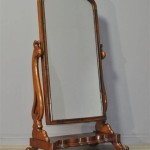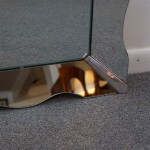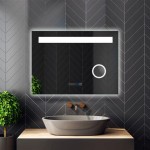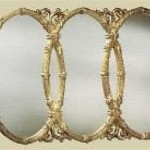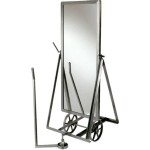How To Make Your Own Vanity Mirror With LED Lights
Creating a custom vanity mirror with integrated LED lighting is a rewarding project that can enhance any room's aesthetic. This guide offers a step-by-step approach to constructing a personalized vanity mirror, providing a clear understanding of the materials required and the construction process.
Materials Required:
Several key components are necessary for this project. These include a mirror, preferably frameless, of the desired size and shape. LED strip lights, available in various colors and brightness levels, are essential for the illumination. A power supply suitable for the chosen LED strips, ensuring voltage compatibility, is required to power the lights. Other necessary materials include wiring, a dimmer switch (optional but recommended), mounting hardware, and a frame or casing for the mirror (optional, depending on the desired design).
Tools Required:
The assembly process necessitates specific tools for precise and efficient construction. These include a measuring tape or ruler for accurate measurements, a pencil or marker for marking, wire cutters/strippers for preparing the wiring, a soldering iron (optional, for more secure connections), a drill with appropriate drill bits for mounting, and a screwdriver compatible with the chosen mounting hardware. Safety glasses are highly recommended for eye protection throughout the process.
Step-by-Step Construction Guide:
1. Planning and Preparation: Begin by determining the desired dimensions of the mirror and planning the placement of the LED lights. Careful measurement and marking on the mirror's surface are crucial for precise light placement. Consider the desired lighting effect, such as a backlit glow or direct illumination, when planning the LED layout.
2. Attaching the LED Strips: The adhesive backing on most LED strips allows for direct application to the mirror's surface. Ensure the surface is clean and dry before applying the strips. Follow the manufacturer's instructions for proper adhesion. For curved mirrors, flexible LED strips are recommended. Precision in this step is vital for a polished final product.
3. Wiring the LED Strips: Connect the LED strips according to the manufacturer's instructions, ensuring correct polarity. If using multiple strips, connect them in parallel or series as needed, considering the power supply's capabilities. Soldering the connections can provide a more secure and durable connection.
4. Installing the Dimmer Switch (Optional): If incorporating a dimmer switch, carefully integrate it into the wiring circuit. This allows for adjustable brightness levels, enhancing the mirror's functionality. Follow the dimmer switch manufacturer's instructions for proper wiring.
5. Connecting the Power Supply: Connect the wiring from the LED strips to the power supply, ensuring proper polarity and secure connections. Select a power supply that matches the voltage and amperage requirements of the LED strips. Test the connections to ensure the lights function correctly before proceeding further.
6. Mounting the Mirror: Depending on the desired design, mount the mirror using appropriate mounting hardware. If using a frame or casing, secure the mirror within the frame before mounting. Ensure the mounting method is secure and capable of supporting the weight of the mirror and components.
7. Concealing the Wiring: For a clean and professional finish, conceal the wiring behind the mirror or within the frame. Use adhesive clips or wire channels to manage the wiring effectively. This step enhances the aesthetic appeal of the finished product.
8. Final Testing and Adjustments: After completing the assembly, conduct a final test to ensure all lights function correctly and the dimmer switch (if used) operates smoothly. Make any necessary adjustments to the wiring or mounting as needed.
Customization Options:
Numerous customization options exist to personalize the vanity mirror further. Different LED colors can create various ambiance effects. Smart LED strips, controllable via smartphone apps, offer dynamic lighting options. Integrating a defogger pad to the mirror's back can prevent fogging in humid environments. Adding decorative elements to the frame or incorporating built-in storage further enhances functionality and personalization.
Safety Precautions:
Safety is paramount throughout the construction process. Always disconnect the power supply before working with wiring. Use appropriate safety glasses to protect eyes from potential debris. Follow the manufacturer's instructions for all components and tools. Ensure proper ventilation when soldering to avoid inhaling fumes. If uncertain about any electrical aspect of the project, consult a qualified electrician.

Diy 20 Light Up Vanity Mirror With Remote

10 Diy Vanity Mirror Projects That Show You In A Diffe Light

Diy Step By Vanity Mirror With Dimmable Led Lights And Usb

Modern Wood And Led Vanity Mirror Diy With Lights Makeup

20 Diy Vanity Mirror Using Led Lights And Easy

10 Diy Vanity Mirror Projects That Show You In A Diffe Light
:max_bytes(150000):strip_icc()/makesandmunchies-c136f898cca640faa72b6209012230cb.jpg?strip=all)
7 Diy Lighted Mirror Ideas To Add A Little Extra Shine Your Space

How To Diy Vanity Mirror With Led Strip Lights

Diy Light Up Vanity Mirrors You Can Make Ohmeohmy Blog

Diy Light Up Vanity Mirrors You Can Make Ohmeohmy Blog


